Discover 5 Animals that Live in the Snow
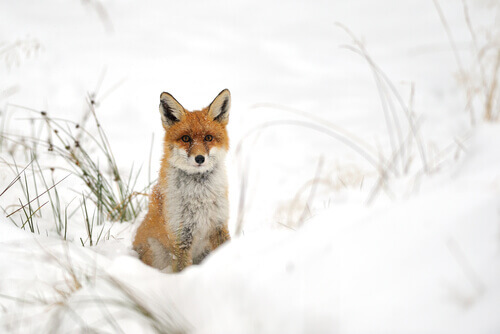
Believe it or not, these species have been able to adapt very well to cold climates and the months when everything turns white. In this article, we’ll tell you about some animals that live in the snow and their techniques to camouflage themselves in the environment. They’re amazing!
Animals that live in the snow: Which ones do you know?
It may seem that in such an inhospitable place, with temperatures below zero and snow wherever you look, life would be impossible. However, there are more animals that live in the snow than you think. Among them we’d like to highlight the following:
1. Red foxes (Vulpes vulpes)
This is one of the most well-known canids, after the dog and the wolf, and it lives in Europe as well as Asia and North America. What’s more, it’s been introduced to Australia. Native cultures have considered this animal as a symbol for centuries.
The red fox, which appears in this article’s cover photo, is very silent and cautious. It hunts at night and, during the day, it hides among the bushes or in burrows among the rocks.
You can find the red fox in different ecosystems: Tundra, forest, taiga, plateau, prairie, and coastal. This is because it adapts very well to the climate and flora. In winter, its fur can become a little lighter to camouflage itself in the snow.
2. Wildcats (Felis silvestris)
This feline is similar in appearance to a domestic cat. In fact, some specimens of both species have been hybridized. This wild mammal lives in Europe as well as in Asia and some areas of Africa. Small in size, but robust in build, the wild cat has gray tiger stripes which are lighter on the belly. It has a good coat of fur that allows it to walk in the snow without problems.
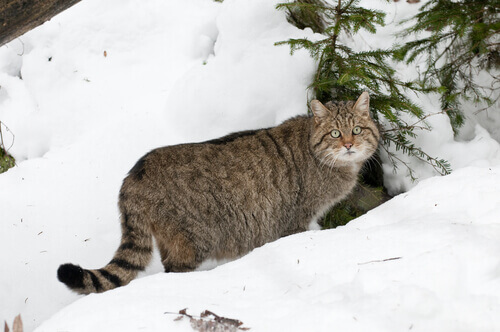
With the exception of the breeding and rearing season, the wildcat is a solitary animal, with its own territory of 1.25 square miles. It can hunt by day or by night – feeding on birds, amphibians and rodents – and it’s quite fierce toward people.
When the mating stage begins, males look for females outside their ‘boundaries’ to reproduce. Mothers give birth to their babies after a little more than three months of gestation, in burrows or in cracks in the rocks. They can have up to eight babies in a single litter. Little ones open their eyes at 12 days and become independent at four months.
3. Badgers
There are three species of badgers and they come from specimens that lived in the Pliocene Epoch. These species are the Japanese, the Asian, and the European. The latter is small, robust and somewhat ‘elongated’, measuring up to 31 inches long (plus some 6 inches of tail). It can weigh about 29 pounds.
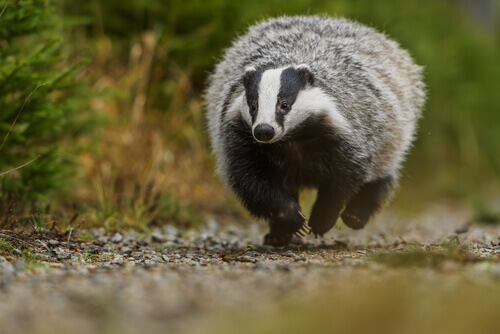
Among the animals that live in the snow, the badger is one that’s been able to adapt to the environment the most. This is thanks to its legs that walk quickly and don’t sink. In addition, its long, mobile snout helps it to find food ‘buried’ in the snowy ground.
4. Mountain hare (Lepus timidus)
This animal belongs to the Lepus family – to which rabbits also belong. It lives in mountainous and polar ecosystems of Siberia, the Alps, Poland, Ireland and the United Kingdom, among others.
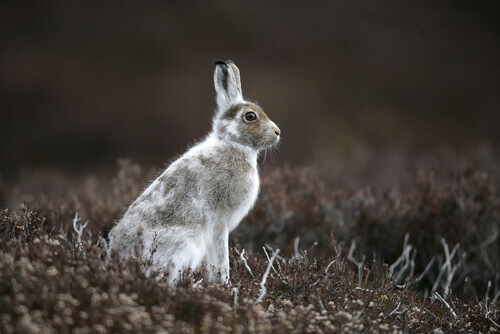
Its coat changes according to the time of year. In the winter, it’s almost white, and in summer, it’s brown or grayish with a white belly and legs. This hare has very long ears, short legs, and a robust body. What’s more, it lives in small burrows and feeds on branches, grass, or leaves.
5. Moose
We tend to relate these gigantic mammals to Santa Claus and to snowy places like Finland or Scotland. The moose is a typical inhabitant of the Nordic and North American forests and has a striking appearance due to its size and its antlers, which are only present in male specimens.
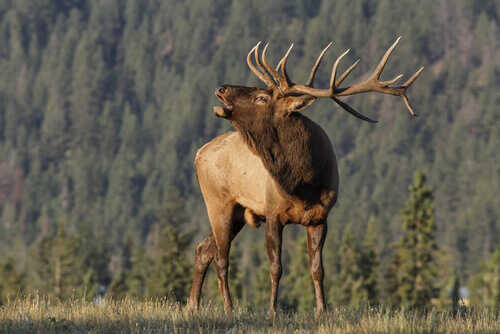
It’s the largest member of the deer family, and has been able to adapt very well to the cold. In that sense, its nose warms the air before it enters the lungs, and its strong legs help it walk on the snow. What’s more, its coat increases its body temperature when temperatures are below zero outside.
All cited sources were thoroughly reviewed by our team to ensure their quality, reliability, currency, and validity. The bibliography of this article was considered reliable and of academic or scientific accuracy.
- Doncaster, C. P., Dickman, C. R., & Macdonald, D. W. (1990). Feeding ecology of red foxes (Vulpes vulpes) in the city of Oxford, England. Journal of Mammalogy, 71(2), 188-194.
- Chernov, Y. I. (1988). The living tundra. CUP Archive.
- Brightman, M., Grotti, V. E., & Ulturgasheva, O. (Eds.). (2012). Animism in rainforest and tundra: personhood, animals, plants and things in contemporary Amazonia and Siberia. Berghahn Books.
- Miller, L. K. (1978). Physiological studies of arctic animals. Comparative Biochemistry and Physiology Part A: Physiology, 59(4), 327-334.
- Bliss, L. C., Courtin, G. M., Pattie, D. L., Riewe, R. R., Whitfield, D. W. A., & Widden, P. (1973). Arctic tundra ecosystems. Annual Review of Ecology and Systematics, 4(1), 359-399.